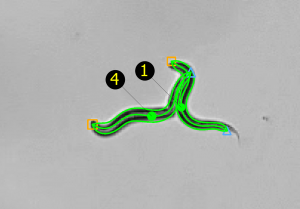
Mutations in a TRP ion channel cause dopaminergic cell loss in C. elegans
Researchers have identified two strains of mutant C. elegans that lose the majority of their dopaminergic neurons in adulthood, a characteristic of neurodegenerative diseases such as Parkinson’s disease and Alzheimer’s disease.
The two strains of mutant C. elegans (ot337 and ot477) showed normal development of dopaminergic neurons, however these neurons began to progressively decline in adulthood; and the deterioration was not an occurrence of the normal aging process, the authors say in their paper published in the Journal of Neuroscience.
After mapping the worms’ entire genome sequence, the researchers pinpointed the site of the mutation – the Transient Receptor Potential (TRP) mechanosensory channel trp-4 – a mutation that has not previously been implicated in dopaminergic neuron death.
“We describe here a novel Caenorhabditis elegans mutant with robust and progressive degeneration of dopaminergic neurons during postembryonic development,” the authors say in their paper. “We show that a single amino acid substitution in a TRP channel is responsible for the phenotype, implicating mutations in TRP family channels as a direct cause of dopaminergic degeneration for the first time.”
The researchers used WormLab, MBF Bioscience’s software for tracking and analyzing C. elegans, to calculate the velocity of worms. A defective basal slowing response in the worms with the TRP mutation was found – meaning these worms did not slow down when food appeared. The basal slowing response is driven by dopaminergic neurons and is a common measure of C. elegans behavior. In contrast to the mutant worms, wild type worms behaved normally, slowing their movements in the presence of food.
According to the paper, the cell death observed by the researchers is a result of the inability of the mutant TRP-4 channel to properly control the influx of the calcium ion, resulting in calcium toxicity in dopaminergic neurons, which the authors say is a characteristic of most major neurodegenerative diseases.
Nagarajan, A., Ning, Y., Reisner, K., Buraei, Z., Larsen, J. P., Hobert, O., & Doitsidou, M. (2014). Progressive Degeneration of Dopaminergic Neurons through TRP Channel-Induced Cell Death. The Journal of Neuroscience, 34(17), 5738-5746.



